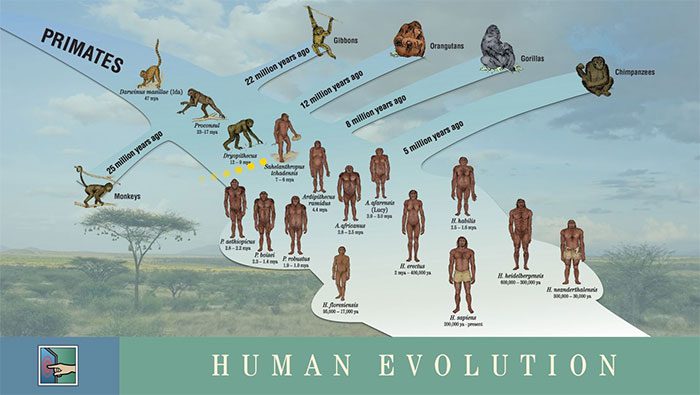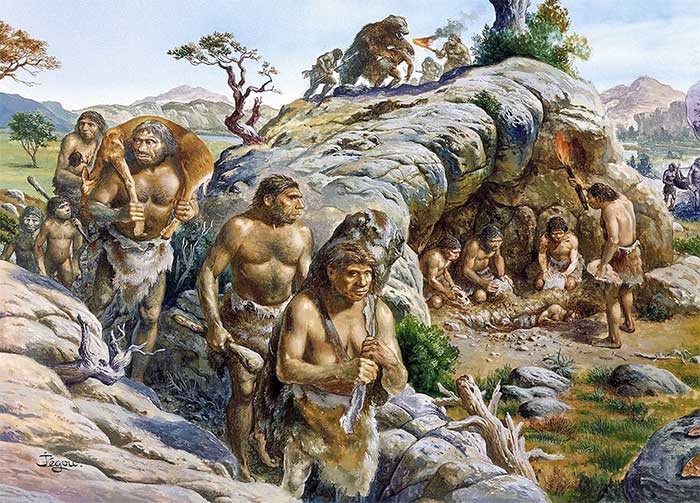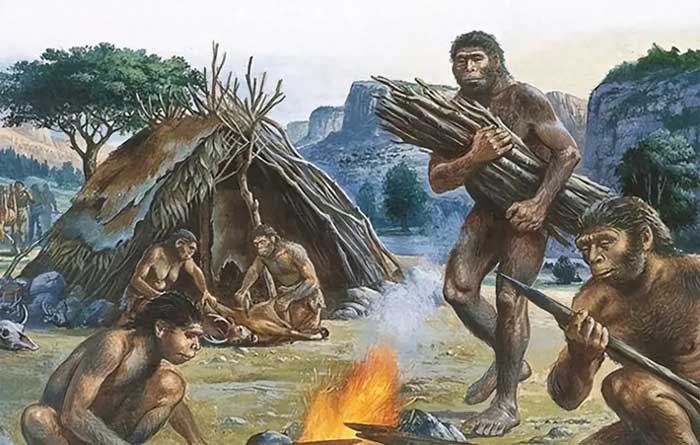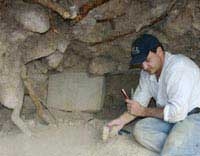In the long evolutionary history of humanity, we were once herbivorous animals. However, during a natural disaster approximately 2.5 million years ago, humans were forced to seek new energy and nutrient sources from various origins.
Humans Become Omnivores
Humans have a highly flexible digestive system allowing us to process a wide variety of foods. Compared to other species, humans possess relatively long intestines, creating an optimal environment for digesting complex carbohydrates. Additionally, our mouths contain digestive enzymes such as amylase and protease, which help us digest starches and proteins more effectively. These traits enable us to derive nutrients from diverse food sources.

The evolutionary process of humanity. (Illustration: Missionblue).
The structure of human teeth is adapted to various types of food. We have different types of teeth, including sharp incisors and canines, as well as molars. These specialized dental structures allow us to cut, bite, and grind different kinds of food. Incisors and canines are suited for tearing meat, while molars and premolars are ideal for chewing fibrous plant material and hard foods.
Humans have also developed intelligence and advanced tool-use capabilities, providing us with significant advantages in food gathering and processing. We can use tools to create and employ various hunting and foraging implements, such as bows and arrows, nets, fishing gear, etc., to collect and catch animal and plant resources. Simultaneously, we can alter the properties and flavors of food through cooking, processing, and baking. This allows us to better utilize the nutrients provided by plants and animals.
Human adaptation to food is also related to culture and environment. Different regions and ethnic groups have varying dietary preferences and habits. For instance, some cultures have plant-based diets, such as rice and beans in Asian countries, while others have meat-based diets, like salmon and beef in Northern European nations. This diverse food selection is also a result of human adaptation to multiple environments and resource availability.

Humans have also developed intelligence and advanced tool-use capabilities. (Illustration: Zhihu).
The Impact of Natural Disasters on Human Evolution
Natural disasters can drive the development of human adaptability and survival skills. In the face of natural catastrophes, humans are compelled to quickly adapt and enhance their survival abilities to escape danger. This strong adaptability is crucial in the biological evolution process. When confronted with disasters, humans must improve their observation skills and crisis response, as well as develop more sensitive cognitive mechanisms and effective survival strategies.
For example, after thousands of years frequently facing floods, humans chose to construct cities on water and floating vessels to combat the threats posed by flooding. This long-term adaptation process has driven the advancement of human civilization and shaped how we live today.
Natural disasters also significantly impact social aspects in human evolution. During large-scale calamities, people must come together to solve difficulties collectively. Cooperation and social cohesion have become key factors for human survival and recovery.
Disasters force people to unite and address challenges together. This fosters a sense of community, strengthening relationships and the development of human societies. The occurrence of certain disasters in history, such as earthquakes and floods, has spurred humans to collaborate in building fortifications and resisting natural calamities. These collective efforts have reshaped our social structures, emphasizing the importance of teamwork and mutual support.

In the face of natural disasters, humans must enhance their survival skills. (Illustration: Missionblue).
The final impact of natural disasters on human evolution is at the genetic level. According to recent studies, individuals from certain groups that survived natural disasters in history often possess gene mutations adapted to disaster-prone environments. These mutations may enable individuals to better withstand and adapt to disaster conditions. Over time, these genes have been genetically passed down to future generations, enhancing the overall resilience of humans.
For instance, in regions frequently afflicted by malaria, genetic variants resistant to malaria parasites gradually become predominant in the population, giving residents in these areas a higher resistance to malaria. Such gene transmission mechanisms are vital to the evolutionary process of humanity. Groups that successfully inherit adaptive genes are more likely to survive when facing future natural disasters.
The Connection Between Human Digestion and Omnivorous Diet
Our mouths and teeth are the starting point of the digestive system. Human teeth have different shapes and functions, including sharp incisors, pointed canines, and sturdy molars. These specialized teeth help us chew a variety of foods. Our incisors are used for crushing food, canines are used for tearing meat, and our molars are used for grinding fibrous plant material.

The omnivorous nature of humans is the result of multiple factors. (Illustration: Zhihu).
Our mouths also contain salivary glands, which produce a type of digestive enzyme called amylase, responsible for breaking down starch into sugars. Amylase begins to work when we chew starchy foods. This also explains why foods like bread or rice taste sweeter as we eat them.
The food then passes through the throat into the esophagus and subsequently into the stomach. The stomach is a highly acidic organ that secretes gastric acid and digestive enzymes to break down food. The presence of these acids and digestive enzymes allows the stomach to digest various foods, including meat, vegetables, and fruits. The acidic environment of the stomach helps eliminate potential bacteria and viruses in the food.
Next, the digestive system pushes undigested food into the small intestine. In the small intestine, food is further broken down and absorbed. The inner walls of the small intestine are lined with numerous tiny structures called “villi,” which significantly increase the surface area for absorption. The presence of this structure facilitates the absorption of nutrients, including carbohydrates, fats, and proteins.

Being omnivorous allows us to access a wider range of nutrients. (Illustration: Zhihu).
Finally, any undigested food particles will enter the large intestine. The large intestine primarily absorbs water and salts and metabolizes food waste into feces. During this process, some beneficial substances such as vitamins K, B, and others may be produced.
Due to the omnivorous nature of the human digestive system, we can access a wider variety of nutrients and are better able to adapt to changes in the environment and food supplies. It is also one of the crucial factors contributing to our success in the evolutionary process.
The reason humans have become omnivorous is a result of multiple factors. Research indicates that large-scale environmental changes occurred on Earth at that time, leading to the extinction of many plant species and disruptions in food chains. Humans during this period faced severe survival challenges and had to adapt to new food sources, including animal flesh and other foods. As a result, humans quickly adapted to an omnivorous diet, which became one of the significant milestones in our evolutionary journey.





















































